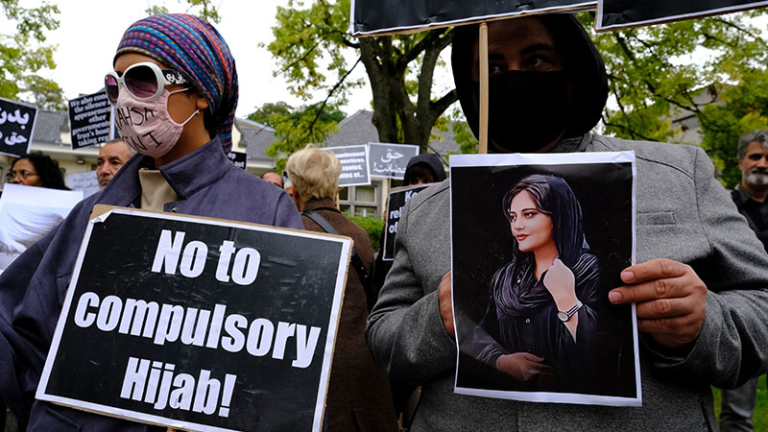
Over the past four months, the international community has been heaping praise on the Iranian people for their audacious uprising, which has been challenging the country’s clerical establishment despite a heavy-handed crackdown that is now being bolstered by a wave of retaliatory executions. The ongoing protest movement, whose spirit and core message have been captured in its unifying slogan, “Woman, Life, Freedom,” was initially ignited by the death of a 22-year-old Kurdish Iranian woman, Mahsa Amini, who died while in the custody of Iran’s “morality police,” a force that millions of Iranians have decried for its brutality and arbitrary enforcement of the country’s repressive laws.
The avalanche of national outrage over Amini’s killing quickly dominated global headlines, and the international media ensured that the voices of the Iranian people were heard, despite a dearth of foreign correspondents on the ground, which made factual reporting a daunting task. With extensive media coverage, including exclusive reports featuring guests providing an insider’s view of the protests and TIME magazine’s recognition of the women of Iran as the heroes of 2022, it is fair to say that international audiences are well informed about the enormity of this extraordinary revolutionary wave.
Four months on, demonstrations in Iran’s major cities and gatherings on university campuses have, to a large extent, subsided, and the movement is not as dynamic as it was in early weeks. But this temporary reduction in momentum does not mean that people have renounced their demands or that their grievances have been addressed. Although protesters’ rallying cry was initially the abolition of the morality police and the repeal of compulsory laws on wearing the hijab, their demands have become more radical over time. With every cycle of clampdowns, which included the Iranian security forces’ detention of prominent figures and their killing of protesters, the numbers of those urging a wholesale transition away from the current regime and an end to the country’s theocracy grew exponentially.
This is not the first time a sprawling protest has rocked the country. Nationwide demonstrations against the rigged 2009 presidential election and widespread unrest in 2017 and 2019, precipitated by the cratering of the national economy, have not yet slipped from Iranians’ collective memory. Those episodes of resistance were also met with an iron fist and quashed relatively quickly, but their long-term impacts have endured.
This time around, however, people appear to be more resilient and more reluctant to give in to pressure to stop demonstrating, even though the establishment refuses to acknowledge their right to protest, repeatedly branding the events that followed the September 16 death of Mahsa Amini as “riots.” The Iranian authorities’ dominant talking point has been that the upheaval was instigated by the United States and other foreign powers that are supposedly interested in undermining the Islamic Republic. But blaming a foreign enemy for crises at home is the government’s typical response when it finds itself facing any sort of opposition.
For many Iranians, the 2022 protests represent an opportunity to seek concrete change and to fight for the fundamental rights they have unjustly been denied. The people’s demands include such simple freedoms as “dancing in the streets” and “yearning for a normal life,” and have been eloquently expressed in the viral song “Baraye” (Because Of), which has become the unofficial anthem of the protest movement. Iranians are expressing their grievances about air pollution, the jailing of intellectuals, discrimination against Afghan child refugees, the extinction of the Persian cheetah, the shame of poverty, and a litany of other social and political problems.
Many observers have been wondering why this uprising has been so protracted and what factors have contributed to people being so tenacious given that previous protests fizzled out shortly after they began. The reasons are manifold, but perhaps the most significant is that many Iranians have grown deeply cynical about the likelihood of reform taking place within the framework of the Islamic Republic, and have therefore concluded that the government is far too obstinate and entrenched to accept any amendments to its policies. For a large segment of the population, it is not merely cynicism, but utter disillusionment with the status quo that is making these protests so long-lasting.
The Iranian people have twice voted for reform by electing Hassan Rouhani as president in 2013 and 2017, and then watched as his efforts to introduce a few basic civil liberties and to overhaul the nation’s foreign relations fell through. Now they are observing how his successor, Ebrahim Raisi, who was anointed as president in the most uncompetitive election since 1979, has wreaked havoc on the national economy, waged war on civil liberties, and thrown the country’s foreign relations into chaos.
Persian-language social media shows general agreement that it was President Raisi’s excesses and his incompetence as chief executive that triggered the uprising, and his botched response to the subsequent outpouring of dissent that caused the longevity of the rebellion. When people took to the streets by the millions in 2009 to rail against perceived election fraud, they still harbored hopes that the Islamic Republic would listen to their voices. But when the ruling elite projected defiance and threw their entire weight behind Raisi, a hardline cleric, to become president in 2021, those hopes were dashed.
But it is not Raisi alone who is responsible for the present mayhem. In the years since the 2018 US withdrawal from the Joint Comprehensive Plan of Action, the Islamic Republic signaled that it predominantly cares about its own survival rather than the Iranian people’s priorities. Bolstering restrictions on the internet, tightening the noose around women’s necks by strengthening compulsory hijab laws, and decimating an already fragile civil society all point to an insidious regime agenda to mutilate the last remnants of the “Republic” side of the “Islamic Republic” and to pave the way for an “Islamic North Korea” of sorts.
Having come to this realization, protesting Iranians have decided to seize the disruptive force of this movement, with its focus on women, life, and freedom, to ignite fundamental change. Although the movement has entered a period of relative quiet, there are almost certainly additional storms on the horizon.
Featured image credit: Shutterstock/Alexandros Michailidis

